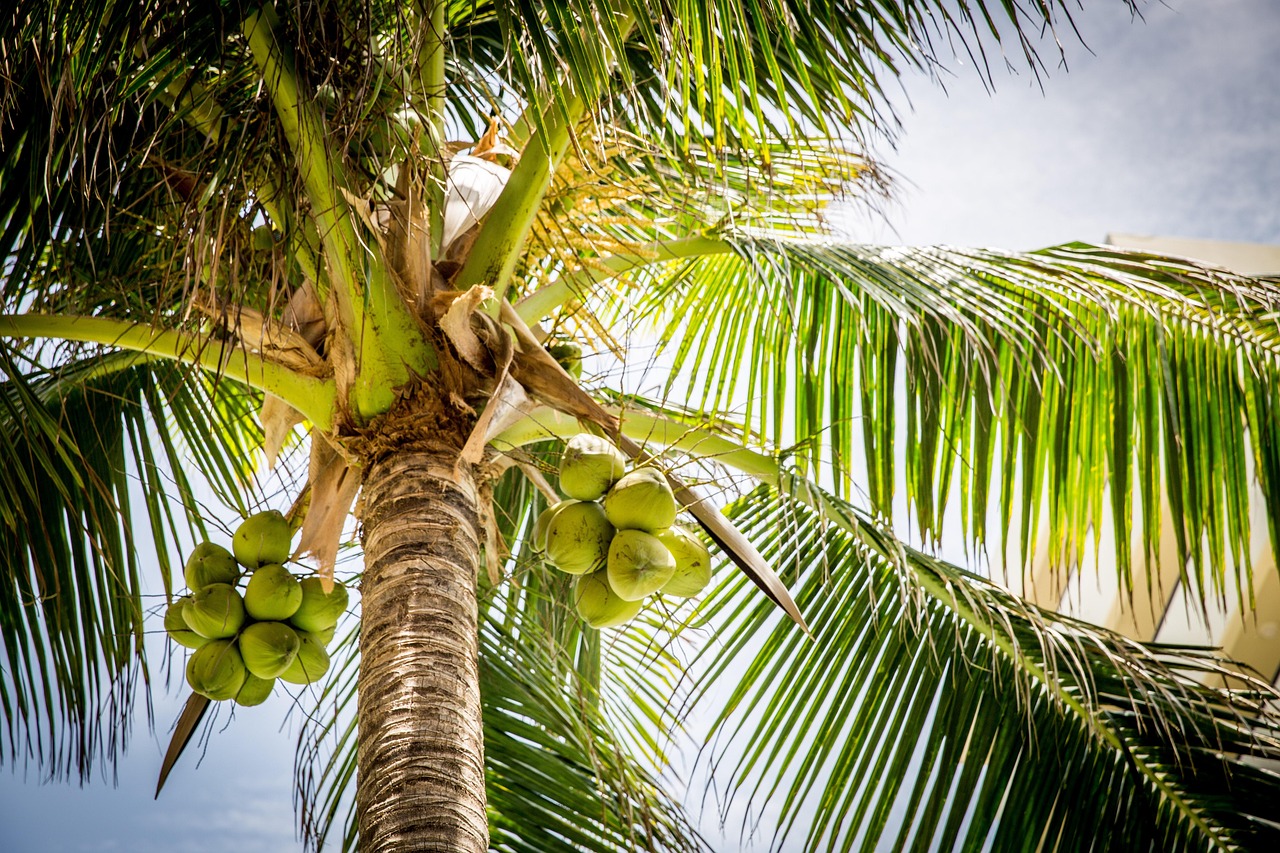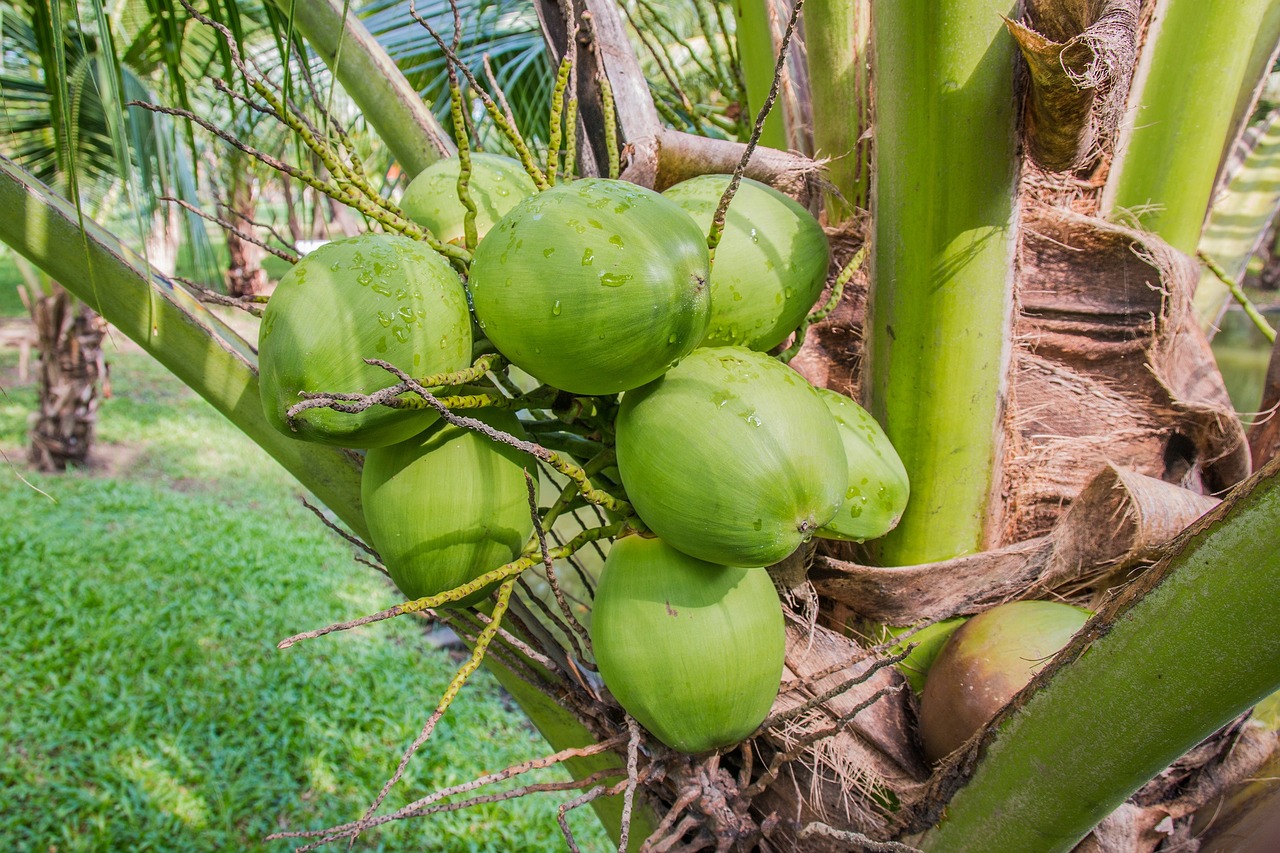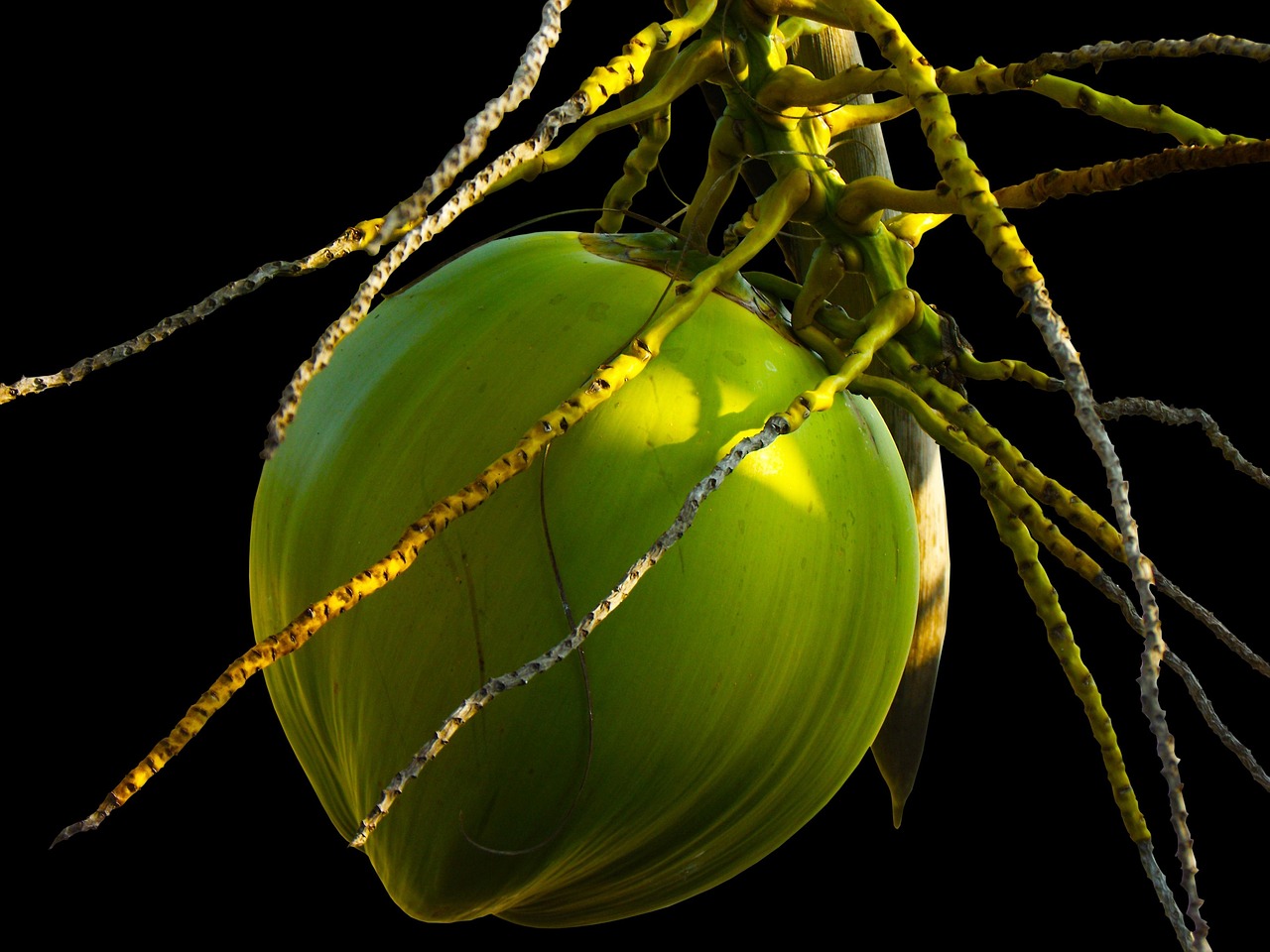Coconut tree pruning is essential for maintaining healthy growth and maximizing fruit production. Regular pruning removes dead or damaged fronds, improves air circulation, and enhances the overall aesthetic of your tropical garden. Proper techniques can also prevent pest infestations and diseases.
The coconut tree (Cocos nucifera) is a staple in tropical gardens. It provides shade, beauty, and nutrition through its fruit. Pruning is crucial to ensure the tree thrives and produces ample coconuts. This maintenance task contributes significantly to the health of the tree and the garden environment. Understanding when and how to prune coconut trees can make a substantial difference in their growth and productivity.

In tropical climates, coconut trees can grow rapidly. This growth can lead to the accumulation of old, dead fronds that may hinder the tree’s ability to photosynthesize effectively. Pruning these fronds allows sunlight to reach the inner leaves, promoting healthier growth. Moreover, it reduces the risk of pests and diseases that thrive in dense foliage.
Understanding Coconut Tree Growth
Coconut trees typically grow to heights of 50 to 80 feet. They have a single trunk with a crown of fronds that can number anywhere from 20 to 30. The growth rate can vary based on species, environmental conditions, and care practices. Below are some key growth characteristics:
| Growth Stage | Height | Frond Count |
|---|---|---|
| Seedling | 1-3 feet | 2-4 |
| Juvenile | 4-10 feet | 5-15 |
| Mature | 10-80 feet | 20-30 |
When coconut trees are young, they require minimal pruning. As they mature, however, regular maintenance becomes vital. Knowing the right time to prune is just as important as understanding how to do it. Generally, the best time to prune coconut trees is during the dry season when the tree is not actively growing.

Benefits of Pruning Coconut Trees
The benefits of pruning coconut trees extend beyond aesthetics. Regular pruning helps in several ways:
- Improves Air Circulation: Removing old fronds enhances airflow around the tree, reducing humidity levels that attract pests.
- Enhances Sunlight Exposure: Pruning allows sunlight to reach all parts of the tree, which is crucial for photosynthesis.
- Prevents Disease: Dead or decaying fronds can harbor pathogens. Regular removal decreases the risk of disease spread.
- Encourages New Growth: Pruning stimulates new frond development, leading to more robust growth.
- Facilitates Harvesting: Keeping the tree well-maintained makes it easier to harvest coconuts.
In addition to these benefits, proper pruning can help maintain the structural integrity of a coconut tree. Heavy fronds can act as sails during storms, potentially causing the tree to topple over. By regularly removing excess weight, you can help secure the tree against wind damage.
Tools Required for Pruning
To effectively prune coconut trees, having the right tools is essential. Here are some recommended tools:

- Loppers: Ideal for cutting through thicker branches and fronds.
- Hand Pruners: Suitable for smaller cuts and detailed work on young trees.
- Saws: A small saw may be required for larger fronds or branches.
- Ladder: A sturdy ladder is necessary for reaching higher fronds safely.
- Safety Gear: Gloves and goggles are recommended to protect against falling debris.
When using tools, always ensure they are sharp and clean. This reduces damage to the tree and minimizes the risk of introducing infections. Using clean tools is particularly important when moving from one tree to another.
Pruning Techniques
The techniques used in pruning coconut trees can vary depending on their age and condition. Here are some effective methods:
- Crown Cleaning: This involves removing dead or dying fronds from the crown without affecting healthy ones.
- Crown Thinning: Reducing the density of fronds allows better light penetration and air circulation.
- Crown Reduction: Reducing the height of the crown may be necessary for safety reasons in areas prone to storms.
When performing these techniques, always cut at an angle to facilitate water drainage. This reduces the risk of rot and disease resulting from stagnant water on cut surfaces.

Coconut tree pruning is both an art and a science. Understanding when and how to prune will ensure your tropical garden flourishes while keeping your coconut trees healthy and productive.
Timing and Frequency of Pruning
Understanding when to prune coconut trees is crucial for effective maintenance. Pruning should align with the growth cycles of the tree and seasonal changes in the environment. Below are some key factors to consider regarding timing and frequency:
- Dry Season: The best time to prune coconut trees is during the dry season. This is when the tree is not actively growing, reducing the risk of stress and disease.
- Young Trees: For young coconut trees, pruning should be minimal and performed once every 1-2 years. Focus on removing any dead or damaged fronds.
- Mature Trees: Mature trees may require pruning every 6-12 months. Regular maintenance helps keep them healthy and productive.
- Post-Harvest: Consider pruning after harvesting coconuts. This allows you to remove fronds that may have been damaged during the harvest process.
In addition to these considerations, always monitor your trees for any signs of distress or disease. If you notice an increase in dead fronds or pest activity, it may indicate the need for more frequent pruning.
Signs That Your Coconut Tree Needs Pruning
Recognizing when a coconut tree requires pruning is vital for maintaining its health. Here are some key signs to look out for:
- Dead or Dying Fronds: If fronds are brown, wilting, or falling off, they should be removed to prevent disease spread.
- Pest Infestation: Presence of pests like coconut beetles can signal the need for pruning to eliminate affected fronds.
- Excessive Crowding: A dense crown can impede sunlight and air flow. If fronds are overcrowded, thinning may be necessary.
- Increased Wind Resistance: If fronds become too heavy, they can increase wind resistance, making the tree vulnerable during storms.
Keeping an eye on these factors will help you decide when to take action and ensure your coconut trees remain healthy and robust.
Safety Precautions While Pruning
Pruning coconut trees can pose risks, especially when using ladders or sharp tools. Implementing safety measures can prevent accidents and injuries. Here are essential safety precautions to follow:
- Use Proper Gear: Always wear gloves, safety goggles, and a hard hat to protect against falling debris.
- Check Equipment: Ensure all tools are in good condition before use. Replace any dull or damaged tools.
- Secure Your Ladder: When using a ladder, make sure it is stable and positioned correctly. Consider having someone hold the base of the ladder for added safety.
- Work in Pairs: Pruning can be dangerous, especially at heights. Having a partner can help ensure safety during the process.
- Avoid Wet Conditions: Prune only when the ground is dry to prevent slipping and falling.
Taking these precautions seriously will help reduce risks associated with pruning coconut trees.
Caring for Your Tools
The longevity and effectiveness of your pruning tools depend on how well you maintain them. Proper care for your tools includes:
- Cleaning: After each use, clean your tools with warm soapy water to remove sap and debris. This helps prevent rust and maintains sharpness.
- Sterilizing: Before moving from one tree to another, sterilize your tools with a solution of bleach and water. This minimizes the risk of spreading diseases.
- Sharpening: Regularly sharpen blades to ensure clean cuts. Dull blades can damage the tree and increase healing time.
- Storage: Store tools in a dry place, away from moisture. Use protective sheaths for blades to prevent accidents.
Caring for your tools not only enhances their performance but also contributes to the overall health of your coconut trees by ensuring clean cuts during pruning.
Common Mistakes to Avoid
Avoiding common pitfalls can lead to more effective pruning practices. Here are several mistakes to watch out for:
- Over-Pruning: Removing too many fronds can stress the tree and hinder growth. Always leave enough healthy fronds for photosynthesis.
- Poor Cutting Techniques: Making cuts too close to the trunk can damage the tree. Always cut at an angle above the node.
- Ineffective Timing: Pruning during wet seasons can lead to rot and disease. Stick to the dry season whenever possible.
- Lack of Planning: Approach pruning with a plan. Random cuts can lead to unsightly trees and poor health.
Avoiding these mistakes will help ensure that your coconut trees remain healthy and productive throughout their lifespan.
Fertilization and Coconut Tree Health
Maintaining a healthy coconut tree requires more than just regular pruning. Fertilization plays a crucial role in promoting growth, enhancing fruit production, and ensuring overall vitality. The nutrients provided through fertilization support the tree in recovering from pruning stress and maintaining its health.
Essential Nutrients for Coconut Trees
Coconut trees require a balanced supply of nutrients for optimal growth. Here are the primary nutrients that contribute to their health:
- Nitrogen: Essential for leaf growth and overall vigor, nitrogen promotes the development of lush green fronds.
- Phosphorus: Important for root development and flowering, phosphorus helps in producing high-quality coconuts.
- Potassium: This nutrient aids in fruit quality and strengthens the tree’s resistance to diseases.
- Magnesium: Crucial for photosynthesis, magnesium helps maintain healthy frond color and growth.
- Calcium: This nutrient supports overall cell structure and helps prevent issues like blossom-end rot.
Applying a balanced fertilizer that contains these nutrients can significantly improve the health of your coconut trees. Over-fertilizing, however, can lead to nutrient burn or other complications, so it is essential to follow recommended guidelines.
Fertilization Schedule
A proper fertilization schedule is vital for maximizing the benefits of fertilization. Here is a general timeline for fertilizing coconut trees:
- Early Spring: Apply a balanced fertilizer at the beginning of the growing season to boost new growth.
- Mid-Summer: A second application can help sustain growth and prepare the tree for fruit development.
- Post-Harvest: After harvesting coconuts, consider applying fertilizer to support recovery and promote new frond growth.
Adjusting the schedule based on your local climate and specific tree needs may be beneficial. Regular soil testing can help determine nutrient levels and inform your fertilization plan.
Watering Practices for Coconut Trees
Watering is another critical aspect of coconut tree maintenance. Proper hydration is essential for growth, especially in young trees. Below are some considerations for effective watering practices:
Water Requirements
Coconut trees thrive in well-drained soils but also need consistent moisture. Here are some key points regarding their water requirements:
- Younger Trees: Young coconut trees typically require more frequent watering, especially during dry spells. Ensure the soil remains moist but not soggy.
- Mature Trees: Once established, mature coconut trees are more drought-resistant. They still benefit from regular watering during prolonged dry periods.
- Rainfall Influence: In regions with regular rainfall, adjust watering schedules accordingly. Excessive watering can lead to root rot.
Watering Techniques
The following techniques can enhance watering efficiency:
- Drip Irrigation: This method delivers water directly to the root zone, minimizing waste and ensuring adequate moisture.
- Soaker Hoses: Soaker hoses can provide slow, deep watering, allowing the soil to absorb moisture effectively.
- Mulching: Applying organic mulch around the base of the tree helps retain moisture and reduce evaporation.
Regularly monitor soil moisture levels to ensure your coconut trees receive adequate hydration without overwatering. A moisture meter can be a helpful tool in this regard.
Pest and Disease Management
Pests and diseases can pose significant threats to the health of coconut trees. Identifying and managing these problems early is essential for maintaining tree vitality. Below are common pests and diseases that affect coconut trees:
Common Pests
- Coconut Mite: This tiny pest can cause yellowing of fronds and reduced fruit yield. Regular monitoring and insecticidal soap treatment can help control infestations.
- Coconut Weevil: These pests bore into the trunk, weakening the tree. Traps and removing infested materials are effective management strategies.
- Caterpillars: Several types of caterpillars feed on fronds. Hand-picking or applying organic pesticides can help manage their populations.
Disease Prevention
Coconut trees are susceptible to various diseases, including:
- Lethal Yellowing: This disease affects the vascular system of the tree. Symptoms include yellowing fronds and fruit drop. Early detection is crucial, as there is no cure.
- Coconut Leaf Blight: Characterized by brown spots on leaves, this disease can lead to significant leaf loss. Fungicidal treatments may be necessary for severe cases.
- Crown Rot: Caused by overwatering or poor drainage, crown rot leads to decay in the crown area. Ensure proper drainage and avoid excess moisture to prevent this issue.
Regularly inspecting your coconut trees for signs of pests or diseases will help you take timely action. Adopting good cultural practices, such as proper watering, fertilization, and pruning, will also strengthen tree defenses against these threats.
The Role of Mulching
Mulching is an effective practice that supports coconut tree health by providing numerous benefits. Here’s how mulching contributes to overall garden maintenance:
- Moisture Retention: Mulch helps retain soil moisture, reducing the need for frequent watering.
- Weed Control: A layer of mulch suppresses weed growth, minimizing competition for nutrients and water.
- Soil Temperature Regulation: Mulch insulates the soil, keeping roots cool during hot weather and warm during cooler months.
- Nutrient Enrichment: Organic mulches decompose over time, adding nutrients back into the soil while improving its structure.
Select organic materials such as wood chips, straw, or shredded leaves for mulching around coconut trees. Apply a layer 2-4 inches thick, keeping it away from the trunk to prevent rot. Regularly replenish mulch as it decomposes to maintain its benefits.
Integrating Coconut Trees into Your Landscape
Coconut trees can enhance the beauty and functionality of your tropical garden. They not only provide shade and aesthetic appeal but also contribute to the overall ecosystem. Here are some tips on how to effectively integrate coconut trees into your landscape:
- Planting Location: Choose a location that allows sufficient space for the tree to grow tall and wide. Ensure it is away from structures and power lines to avoid future conflicts.
- Companion Planting: Pair coconut trees with other tropical plants such as banana trees, hibiscus, or ornamental grasses. These plants can thrive in similar conditions and create a lush garden atmosphere.
- Design Considerations: Use coconut trees as focal points in your garden design. Their tall stature can provide vertical interest and create a natural canopy for lower-growing plants.
- Functional Uses: Consider planting coconut trees near areas where you enjoy outdoor activities. Their shade can make spaces like patios or decks more comfortable.
By thoughtfully placing coconut trees within your landscape, you can create a harmonious environment that benefits both the plants and the people who enjoy the garden.
Long-Term Maintenance Practices
Maintaining coconut trees goes beyond pruning and watering; it involves a holistic approach to care that ensures their health over the years. Here are some long-term maintenance practices to consider:
- Regular Inspections: Schedule periodic inspections of your coconut trees to check for signs of pests, diseases, or structural issues. Early detection can lead to effective management.
- Soil Testing: Conduct soil tests every few years to assess nutrient levels and soil pH. This information will guide your fertilization strategies and help you adjust based on the tree’s needs.
- Seasonal Care: Adapt your care routine according to seasonal changes. In the rainy season, focus on drainage and disease prevention, while in dry spells, prioritize watering and fertilization.
- Community Engagement: Connect with local gardening groups or agricultural extensions for advice on best practices and pest management specific to your region.
Implementing these long-term practices will contribute to the sustainability and productivity of your coconut trees, making them a valuable asset in your tropical garden.
Understanding Environmental Impact
Coconut trees play a significant role in their environment. Understanding their ecological contributions can enhance your appreciation for these plants. Consider the following aspects:
- Biodiversity Support: Coconut trees provide habitat for various wildlife, including birds and insects. By maintaining healthy trees, you support local biodiversity.
- Soil Health Improvement: The organic matter from fallen fronds and coconuts contributes nutrients back into the soil, enhancing soil structure and fertility.
- Carbon Sequestration: Like all trees, coconut palms absorb carbon dioxide during photosynthesis, helping mitigate climate change effects.
By recognizing these environmental impacts, you can further appreciate the importance of cultivating coconut trees in your garden while contributing positively to your local ecosystem.
Final Thoughts
Coconut tree pruning and maintenance is an essential aspect of managing a tropical garden. By understanding the proper techniques, timing, and care practices, you can ensure that your coconut trees thrive and contribute to the beauty and functionality of your landscape.
The key takeaways include the importance of regular pruning to maintain health, effective watering and fertilization strategies, and the integration of these trees into a well-designed landscape. Additionally, being aware of pests, diseases, and environmental impacts will empower you to manage your coconut trees sustainably.
Ultimately, with proper care and attention, coconut trees can flourish in your tropical garden, providing shade, beauty, and delicious fruits for years to come. Embrace the journey of nurturing these remarkable trees and enjoy the rewards they bring to both your garden and your lifestyle.
